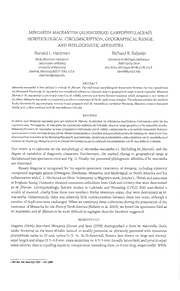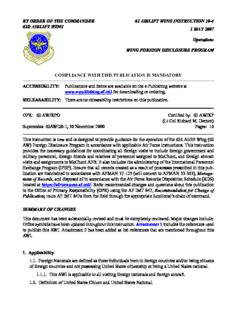
Women's health and fitness magazines: An accurate portrayal? PDF
Preview Women's health and fitness magazines: An accurate portrayal?
UNLV Theses, Dissertations, Professional Papers, and Capstones 5-2009 WWoommeenn''ss hheeaalltthh aanndd fifittnneessss mmaaggaazziinneess:: AAnn aaccccuurraattee ppoorrttrraayyaall?? Jennifer M. Shymansky University of Nevada, Las Vegas Follow this and additional works at: https://digitalscholarship.unlv.edu/thesesdissertations Part of the Gender and Sexuality Commons, Health Communication Commons, Immune System Diseases Commons, Journalism Studies Commons, and the Virus Diseases Commons RReeppoossiittoorryy CCiittaattiioonn Shymansky, Jennifer M., "Women's health and fitness magazines: An accurate portrayal?" (2009). UNLV Theses, Dissertations, Professional Papers, and Capstones. 1140. http://dx.doi.org/10.34917/2512392 This Thesis is protected by copyright and/or related rights. It has been brought to you by Digital Scholarship@UNLV with permission from the rights-holder(s). You are free to use this Thesis in any way that is permitted by the copyright and related rights legislation that applies to your use. For other uses you need to obtain permission from the rights-holder(s) directly, unless additional rights are indicated by a Creative Commons license in the record and/ or on the work itself. This Thesis has been accepted for inclusion in UNLV Theses, Dissertations, Professional Papers, and Capstones by an authorized administrator of Digital Scholarship@UNLV. For more information, please contact digitalscholarship@unlv.edu. WOMEN'S HEALTH AND FITNESS MAGAZINES: AN ACCURATE PORTRAYAL? by Jennifer M. Shymansky Bachelor of Arts Bloomsburg University of Pennsylvania 2006 A thesis submitted in partial fulfillment of the requirements for the Master of Arts Degree in Journalism & Media Studies Hank Greenspun School of Journalism & Media Studies Greenspun College of Urban Affairs Graduate College University of Nevada, Las Vegas May 2009 UMI Number: 1472490 INFORMATION TO USERS The quality of this reproduction is dependent upon the quality of the copy submitted. Broken or indistinct print, colored or poor quality illustrations and photographs, print bleed-through, substandard margins, and improper alignment can adversely affect reproduction. In the unlikely event that the author did not send a complete manuscript and there are missing pages, these will be noted. Also, if unauthorized copyright material had to be removed, a note will indicate the deletion. UMI® UMI Microform 1472490 Copyright 2009 by ProQuest LLC All rights reserved. This microform edition is protected against unauthorized copying under Title 17, United States Code. ProQuest LLC 789 East Eisenhower Parkway P.O. Box 1346 AnnArbor, Ml 48106-1346 Thesis Approval The Graduate College University of Nevada, Las Vegas April 21 .20 09 The Thesis prepared by Jennifer M. Shymansky Entitled Women's Health and Fitness Magazines: An Accurate Portrayal? is approved in partial fulfillment of the requirements for the degree of Master of Arts in Journalism and Media Studies Examination Committee Chair Dean of the Graduate College Examination Committee Memh/r raduate (Lolleoe Facultv-Representative 1017-53 11 ABSTRACT Women's Health and Fitness Magazines: An Accurate Portrayal? by Jennifer M. Shymansky Dr. Anthony J. Ferri, Examination Committee Chair Professor of Journalism and Media Studies University of Nevada, Las Vegas This study is a content analysis examining the representation of health information, particularly the leading causes of death, in cover story headlines of one year of the top women's health and fitness magazines: Prevention, Shape, Fitness, Self, Health and Women 's Health. The study is grounded in social responsibility theory, a normative media theory. The findings show that women's health and fitness magazines' cover story headlines predominately discuss diet and exercise for weight loss, rather than the leading causes of death facing women. This under representation of actual societal health concerns can limit the vast readerships' health knowledge and awareness, and therefore their ability to understand their risks and take proper precautions to protect themselves. 111 TABLE OF CONTENTS ABSTRACT iii LIST OF TABLES v CHAPTER1 INTRODUCTION 1 Purpose of the Study 2 Significance of Study 3 CHAPTER 2 REVIEW OF RELATED LITERATURE 7 Women and Health 7 Research on Popular Women's Magazines 11 Advertising in Popular Women's Magazines 14 Health and Fitness Magazines 15 Knowledge versus Perception of Risk 18 Gaps in Research 27 Theoretical Framework 28 Research Questions 30 CHAPTER 3 METHODOLOGY 31 Collection of Data 31 Treatment of Data 32 Intercoder Reliability 36 CHAPTER 4 FINDINGS OF THE STUDY 38 Analysis of Data 38 Research Questions 39 Summary of Data 45 CHAPTER 5 SUMMARY, CONCLUSIONS, AND RECOMMENDATIONS 47 Discussion 47 Limitations 51 Conclusion 52 APPENDIX 57 Coding Scheme Index 57 BIBLIOGRAPHY 58 VITA 66 IV LIST OF TABLES Table 1 Frequency of headline topics 40 Table 2 Percentages of headlines in three main categories .....43 Table 3 Percentages of leading causes of death headlines on magazines' covers 44 v CHAPTER 1 INTRODUCTION The media yield the power to influence what consumers see and when they see it. Many media consumers rely on their preferred media platform to get information about issues of interest. Whether it is via television, Internet, radio, or print, these consumers often tura to the media to receive information on topics ranging from sports to finances, current news and trends, and even issues involving family or their health (Barnett, 2006; McKay, 2000; O'Keefe, Boyd, & Brown, 1998; "Women are unaware," 2003). Magazines often serve as the primary, and at times sole, form of information for its readers, including information on the health concerns facing women today (Kerwin, 1999; Mosca, Jones, King, Ouyang et al., 2000; O'Keefe, Boyd, & Brown, 1998; "Where women get," 2000; "Women are unaware," 2003). Magazines appear to be particularly influential among young women, given they play a large role in what types of information these readers value (Davalos, Davalos, & Layton, 2007). Women are often unaware of specific diseases, symptoms and medications that directly affect them (Jones, Denham, & Springston, 2007; Mosca et al., 2000; University of Pennsylvania Health System [UPHS], 2006; "Women are unaware," 2003). While most magazines today have a section dedicated to health and/or fitness, these sections are somewhat superficial in that they offer minimal coverage relating to in-depth health issues (Kogan et al., 2003; Pratt et al., 1996; Westin & Ruggiero, 1986). Given the role of women's health and 1 fitness magazines in influencing and shaping the health knowledge of women today, it would be expected that women's health and fitness magazines would take responsibility to their female readership, and expose the numerous illnesses, diseases, and health conceras salient to them. This study examined the role of popular women's health and fitness magazines in providing health information to their readers from other popular magazines available. It analyzed the representation of health issues affecting women as seen on popular women's health and fitness magazines' covers. There exists a recent, increased interest in the health and fitness industry across the United States (Hoover's, Inc., n.d.). In particular, women's health and fitness magazines have grown in response to this surge, with the top five magazines having a circulation of 9.4 million within the first six months of 2006 (Magazine Publishers of America). The National Directory of Magazines includes information on more than 16,500 magazines, tabloids, specialized newspapers, and major journals that carry advertising. Its publication titles are divided into 260 subject categories, of which Health & Fitness remains a top category with 488 titles (Hendrickson, 2008). The prevalence of women's health and fitness magazines is important to recognize when studying their role in distributing factual information to their readers. Purpose of the Study The purpose of this present study was to determine if the headlines of the most popular women's health and fitness magazines depicted the dominant health concerns facing women today. The study was designed to investigate how frequently six popular women's health and fitness magazines cover women's health issues. 2 In order to accomplish this, this study analyzed the relationship between the headlines of these popular magazines and actual societal conditions in the area of women's health today, in particular the leading causes of death for women. One goal was to determine if the stories receiving the dominant cover-story location on each magazine were representative of health concerns facing women, as indicated by women's health statistical data of the same time period. Significance of Study Hard-copy magazines have been around for over a century. Readers of magazines appreciate the structure and the layout, allowing them to partake in a journey throughout their reading. Magazines allow readers to pick and choose where to start and stop, as well as keep them actively engaged throughout the process (McCann, 2005). Magazines can be considered a customized reading experience, in that the reader has the ability to start and stop and skip around throughout the reading. Readers can pick those articles they find particularly interesting, while ignoring other articles. They offer a wide range of genres, maintain a relatively long shelf-life, and are considered a low brow form of entertainment (McLoughlin, 2000). And, perhaps most importantly, magazine readership, despite numerous new media options, has remained stable, or even slightly increased ("10-year magazine," 2006; McKay, 2000). And women aged 18-34 make up the demographic with the highest average issues read per month, showing a .7 increase between 1997 and 2006. Women aged 35-49 were unchanged, while the 50+ demographic also increased, .6, during the same time frame ("10-year magazine," 2006). 3
Description:The list of books you might like

$100m Offers

The Silent Patient

Rich Dad Poor Dad

The 5 Second Rule: Transform your Life, Work, and Confidence with Everyday Courage

Greek Government Gazette: Part 7, 2006 no. 895

Bürgerliches Recht II. Schuldrecht Allgemeiner Teil, 3. Auflage

2016 / 12 / 21 ولغاية 2016 1 1

Einstein Product Metrics in Diverse Dimensions

Greek Government Gazette: Part 7, 2006 no. 837

Caracterización de capacidades

c - Alaska District

Healthcare operations management

C: A linguagem de programação - Padrão Ansi

Parásitos

Chhattisgarh Gazette, 2006-01-20, EO Gazette 22, Notice 605 / 24 / 21-अ / प्रारूपण / 06.-

NASA Technical Reports Server (NTRS) 20080026132: Fault Management Techniques in Human Spaceflight Operations

C11 byanyothername

CAUT Bulletin June 2006 (Volume 53, Number 6)

DTIC ADA440727: Clausewitz and the Persian Gulf War

A survey of the genus Chonala Moore, 1893 with description of a new species




